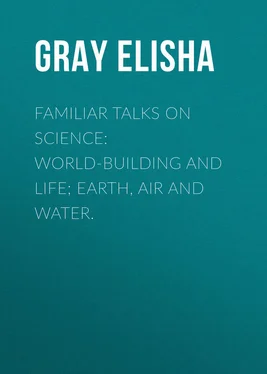Elisha Gray - Familiar Talks on Science - World-Building and Life; Earth, Air and Water.
Здесь есть возможность читать онлайн «Elisha Gray - Familiar Talks on Science - World-Building and Life; Earth, Air and Water.» — ознакомительный отрывок электронной книги совершенно бесплатно, а после прочтения отрывка купить полную версию. В некоторых случаях можно слушать аудио, скачать через торрент в формате fb2 и присутствует краткое содержание. Жанр: foreign_home, foreign_antique, foreign_prose, на английском языке. Описание произведения, (предисловие) а так же отзывы посетителей доступны на портале библиотеки ЛибКат.
- Название:Familiar Talks on Science: World-Building and Life; Earth, Air and Water.
- Автор:
- Жанр:
- Год:неизвестен
- ISBN:нет данных
- Рейтинг книги:5 / 5. Голосов: 1
-
Избранное:Добавить в избранное
- Отзывы:
-
Ваша оценка:
- 100
- 1
- 2
- 3
- 4
- 5
Familiar Talks on Science: World-Building and Life; Earth, Air and Water.: краткое содержание, описание и аннотация
Предлагаем к чтению аннотацию, описание, краткое содержание или предисловие (зависит от того, что написал сам автор книги «Familiar Talks on Science: World-Building and Life; Earth, Air and Water.»). Если вы не нашли необходимую информацию о книге — напишите в комментариях, мы постараемся отыскать её.
Familiar Talks on Science: World-Building and Life; Earth, Air and Water. — читать онлайн ознакомительный отрывок
Ниже представлен текст книги, разбитый по страницам. Система сохранения места последней прочитанной страницы, позволяет с удобством читать онлайн бесплатно книгу «Familiar Talks on Science: World-Building and Life; Earth, Air and Water.», без необходимости каждый раз заново искать на чём Вы остановились. Поставьте закладку, и сможете в любой момент перейти на страницу, на которой закончили чтение.
Интервал:
Закладка:
All animals seem to require salt, and it is claimed by those who have tried the experiment that after one has refrained from the use of salt for a certain length of time the craving for it becomes exceedingly painful. It is most likely that the taste for salt is a natural craving. In any event, whether it is a natural or an artificial taste, it has become an article of the greatest importance in the preparation of food, as well as on account of its use in the arts. Salt is a compound of chlorine and sodium. In chemical language it is called sodium chloride. The symbol is NaCl, which means that a molecule of salt is composed of one atom of sodium and one of chlorine. Chlorine is an exceedingly poisonous gas.
Formerly the chemist when he wished to obtain sodium extracted it from common salt and discharged the chlorine gas into the air. It was found that in establishments where the manufacture of sodium was conducted on a large scale the destructive properties of the chlorine discharged into the air was such that all vegetation was killed for some distance around the manufactory. This came to be such a nuisance that the manufacturers were either compelled to stop business or in some way take care of the chlorine. This is done at the present day by uniting the chlorine gas with common lime, forming a chloride of lime, which is used for bleaching and purifying purposes.
Salt is found in great quantities as a natural product under the name of rock salt. It is found in some parts of the world in great veins over 100 feet in thickness. In some cases the rock salt is mined, when it has to be purified for commercial purposes. The common mode of obtaining salt, however, is by pumping the solution from these great beds where it is mingled with water – salt water; the water is then evaporated, and when it reaches a certain stage of evaporation the salt crystallizes and falls to the bottom.
Different substances crystallize in different forms. The crystallization of water when it freezes, as we shall see hereafter, arranges its molecules in such a form as to make a lump of ice of given dimensions lighter than the same dimensions of water would be. Salt in crystallizing does not follow the same law; the salt crystal is in the shape of a cube and is denser in its crystalline form than in solution, hence it is heavier and falls to the bottom.
It is said that there is a deposit of rock salt in Galicia, Austria, covering an area of 10,000 square miles. There are also very large deposits in England, the mining of which has become a great industry. There are also great beds of salt in various parts of the United States, notably near Syracuse, N. Y., where large salt deposits were exposed in an old river bed formed in preglacial times. The common mode of preparing salt for domestic purposes is by the process of evaporation from brine that has been pumped from salt wells. The quality of the salt is determined largely by the temperature at the time of evaporating the water from it. Ordinary coarse salt, such as is used for preserving meat or fish, is made at a temperature of about 110 degrees; what is known as common salt is made at a temperature of about 175 degrees; while common fine or table salt is made at a temperature of 220 degrees. Thus it will be seen that the process of granulation with reference to its fineness is determined by the rapidity of evaporation. Salt is one of the principal agents in preserving all kinds of meats against putrefaction. It will also preserve wood against dry rot. Vessel builders make use of this fact to preserve the timbers used in the construction of the vessels.
Salt at the present day is very cheap, but at the beginning of the present century it was worth from $60 to $70 per ton. The methods of decomposing salt to obtain its constituents, which are used in various other compounds, are very simple to-day as compared with the processes that prevailed in the days before the advent of electricity in large volume, such as is produced by the power of Niagara Falls. It is curious to note that a substance so useful and so harmless as common salt should be made out of two such refractory and dangerous elements as chlorine and sodium. Both of these elements, standing by themselves, seem to be out of harmony with nature, but when combined there are few substances that serve a better purpose.
These great salt beds that are found to exist in England and America and other parts of the world were undoubtedly deposited from the water of the ocean at some stage in the formation of the earth's crust. It is well known that sea water is exceedingly saline; 300 gallons of sea water will produce a bushel of salt. Undoubtedly beds of salt are also formed by inland lakes, such as the Great Salt Lake in Utah. Only about 2.7 per cent. of ocean water is salt, while the water of the Great Salt Lake of Utah contains about 17 per cent. When there is so much salt in water that it is called a saturated solution, salt crystals will form and drop to the bottom, which process will in time build up under a large body of salt water a great bed of rock salt.
The water in all rivers and springs contains salt to a certain degree, and where it runs into a basin like that of a lake with no outlet, through the process of evaporation pure water is being constantly carried off, leaving the salt behind. It is easy to see that if this process is kept up long enough the water will become in time a saturated solution, when crystallization sets in and precipitation follows, accounting for the deposits of rock salt.
AIR
CHAPTER VI
THE ATMOSPHERE
Meteorology is a science that at one time included astronomy, but now it is restricted to the weather, seasons, and all phenomena that are manifested in the atmosphere in its relation to heat, electricity, and moisture, as well as the laws that govern the ever-varying conditions of the circumambient air of our globe. The air is made up chiefly of oxygen and nitrogen, in the proportions of about twenty-one parts of oxygen and seventy-nine parts nitrogen by volume, and by weight about twenty-three parts oxygen and seventy-seven of nitrogen. These gases exist in the air as free gases and not chemically combined. The air is simply a mixture of these two gases.
There is a difference between a mixture and a compound. In a mixture there is no chemical change in the molecules of the substances mixed. In a compound there has been a rearrangement of the atoms, new molecules are formed, and a new substance is the result.
About 99-1/2 per cent. of air is oxygen and nitrogen and one-half per cent. is chiefly carbon dioxide. Carbon dioxide is a product of combustion, decay, and animal exhalation. It is poison to the animal, but food for the vegetable. However, the proportion in the air is so small that its baneful influence upon animal life is reduced to a minimum. The nitrogen is an inert, odorless gas, and its use in the air seems to be to dilute it, so that man and animals can breathe it. If all the nitrogen were extracted from the air and only the oxygen left to breathe, all animal life would be stimulated to death in a short time. The presence of the nitrogen prevents too much oxygen from being taken into the system at once. I suppose men and animals might have been so organized that they could breathe pure oxygen without being hurt, but they were not, for some reason, made that way.
Air contains more or less moisture in the form of vapor; this subject, however, will be discussed more fully under the head of evaporation. The air at sea-level weighs fifteen pounds to the square inch, and if the whole envelope of air were homogeneous – the same in character – it would reach only about five miles high. But as it becomes gradually rarefied as we ascend, it probably extends in a very thin state to a height of eighty or ninety miles; at least, at that height we should find a more perfect vacuum than can be produced by artificial means. The weight of all the air on the globe would be 11-2/3 trillion pounds if no deduction had to be made for space filled by mountains and land above sea-level. As it is, the whole bulk weighs something less than the above figures.
Читать дальшеИнтервал:
Закладка:
Похожие книги на «Familiar Talks on Science: World-Building and Life; Earth, Air and Water.»
Представляем Вашему вниманию похожие книги на «Familiar Talks on Science: World-Building and Life; Earth, Air and Water.» списком для выбора. Мы отобрали схожую по названию и смыслу литературу в надежде предоставить читателям больше вариантов отыскать новые, интересные, ещё непрочитанные произведения.
Обсуждение, отзывы о книге «Familiar Talks on Science: World-Building and Life; Earth, Air and Water.» и просто собственные мнения читателей. Оставьте ваши комментарии, напишите, что Вы думаете о произведении, его смысле или главных героях. Укажите что конкретно понравилось, а что нет, и почему Вы так считаете.












